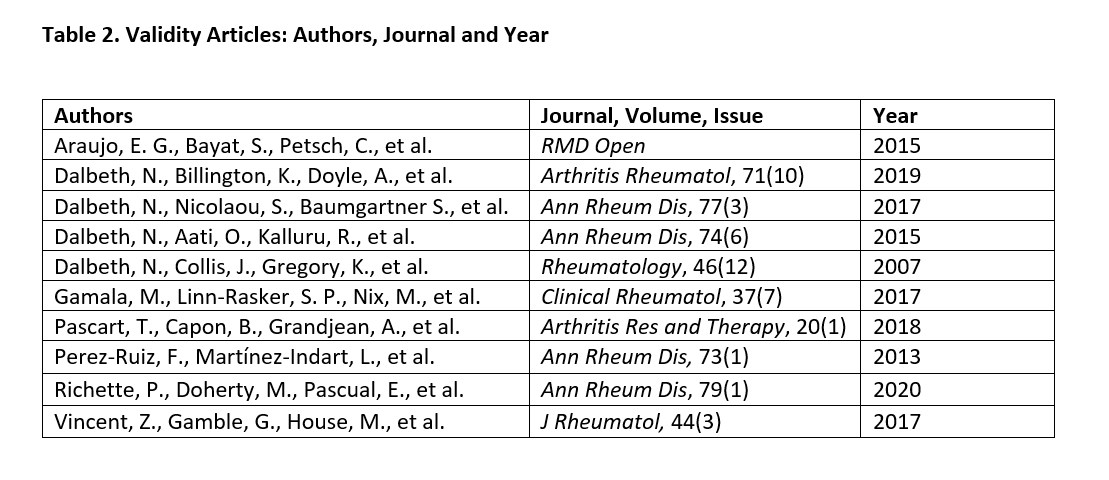Session Information
Session Type: Poster Session B
Session Time: 9:00AM-11:00AM
Background/Purpose: Dual Energy CT Scan (DECT) can detect monosodium urate crystals in joints and periarticular tissues. EULAR gout guidelines (Richette, 2020) recognized DECT’s value in making a clinical diagnosis, when joint aspiration is difficult. DECT demonstrates crystal depositions in 50% of gout patients without tophi (Dalbeth 2017). Since clinical tophi predict excess all-cause and cardiovascular mortality (Vincent 2017 & Perez-Ruiz 2013) it’s possible that subclinical urate depositions on DECT could provide more prognostic information. To have prognostic value, DECT should be reliable and valid. Validity should be evident on measures of death, disability and distress (pain, gout flares). We used a best evidence synthesis framework to and summarize the evidence for DECT as a prognostic gout tool.
Methods: PUBMED and EMBASE were searched from initiation to December 2019, keywords (DECT, gout, tophaceous gout, chronic gout, monosodium urate crystals OR monosodium urate burden OR tophi OR monosodium urate volume OR flares OR pain OR distress OR death OR disability OR function). Titles, abstracts and full articles were identified and supplemented with a manual search of secondary sources. Data extraction was conducted by both authors; final data inclusion represents consensus.
Results: Of 344 eligible articles, 76 titles/abstracts met screening inclusion criteria (22%); a full manuscript was pulled. Thirty-nine articles informed this analysis (11.3%). Four systematic reviews showed high DECT reliability; intra-class correlations, 0.78-0.99. DECT has content validity. Dalbeth (2015) showed DECT and X-Rays correlate with feet erosion scores in tophaceous gout patients, r=0.70, p< 0.001. Vincent (2017) and Perez-Ruiz (2013) showed clinical tophi associated with increased mortality; no study has examined mortality against DECT volume. Dalbeth (2007) showed hand function, (Sollerman Hand Disability Score), correlated with tophi burden (r2=0.59, p=0.024); no study has examined DECT volume with foot or knee function. Higher DECT volumes associate with gout flares. Dalbeth (2017) showed DECT associated with greater flare recall over 3 and 12 months (p< 0.01) in 152 patients. Pascart (2018) showed an odds ratio of 2.03 (95% CI: 1.15-4.38) for flares in 36 patients over 1 year; flared subjects had near doubled DECT knee volumes vs. non-flaring subjects (0.6 cm3 vs 1.1 cm3). Dalbeth (2019) correlated DECT volume and flares at 2 years, r=0.36, p< 0.001. Dalbeth (2017) showed DECT is abnormal in controlled and uncontrolled gout. DECT scans of hands/wrists, feet/ankles/Achilles, knees were abnormal in 47% of those with uric acid < 6.0 mg/dL and no palpable tophi; DECT was abnormal in 90% with uric acid >6.0 mg/dL and palpable tophi. DECT is sensitive to change with therapy. Araujo (2015) showed a 95% change in DECT volume in 152 patients receiving pegloticase. DECT volume decreased from 9.15 to 1.89 cm3 over 12 months.
Conclusion: DECT imaging is highly reliable and has content validity in gout. There is evidence of added prognostic value with DECT, especially for future gout flares. DECT is sensitive to change with urate lowering therapy. Future studies should evaluate DECT’s ability to predict mortality and disability in gout.
To cite this abstract in AMA style:
Stauder S, Peloso P. Dual Energy CT Has Additional Prognostic Value over Clinical Measures in Gout Including Tophi: Best Evidence Synthesis [abstract]. Arthritis Rheumatol. 2020; 72 (suppl 10). https://acrabstracts.org/abstract/dual-energy-ct-has-additional-prognostic-value-over-clinical-measures-in-gout-including-tophi-best-evidence-synthesis/. Accessed .« Back to ACR Convergence 2020
ACR Meeting Abstracts - https://acrabstracts.org/abstract/dual-energy-ct-has-additional-prognostic-value-over-clinical-measures-in-gout-including-tophi-best-evidence-synthesis/


